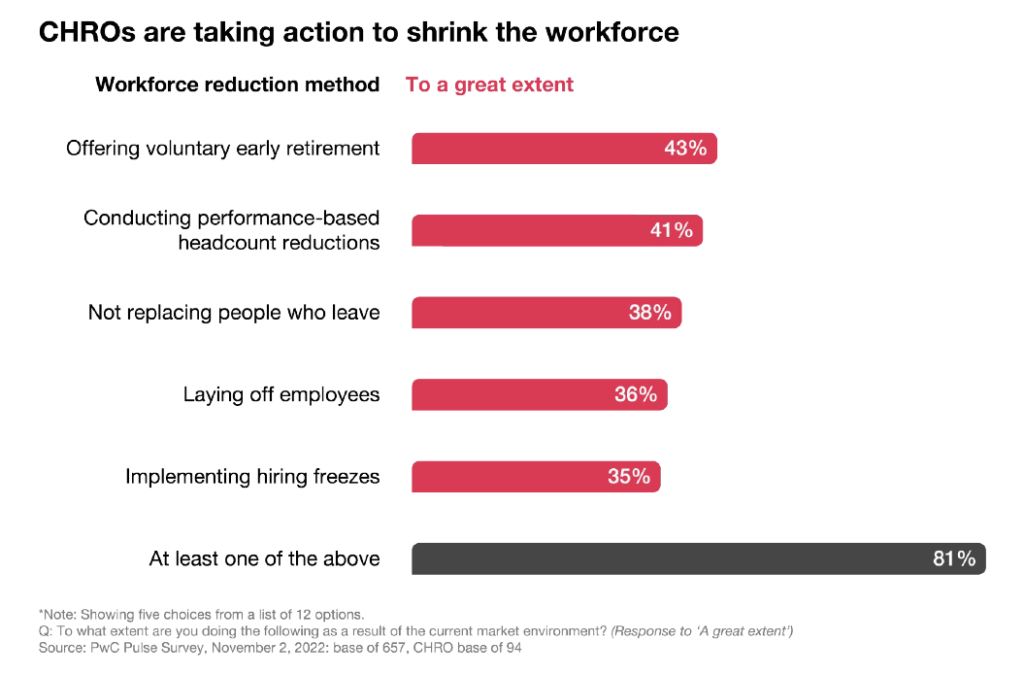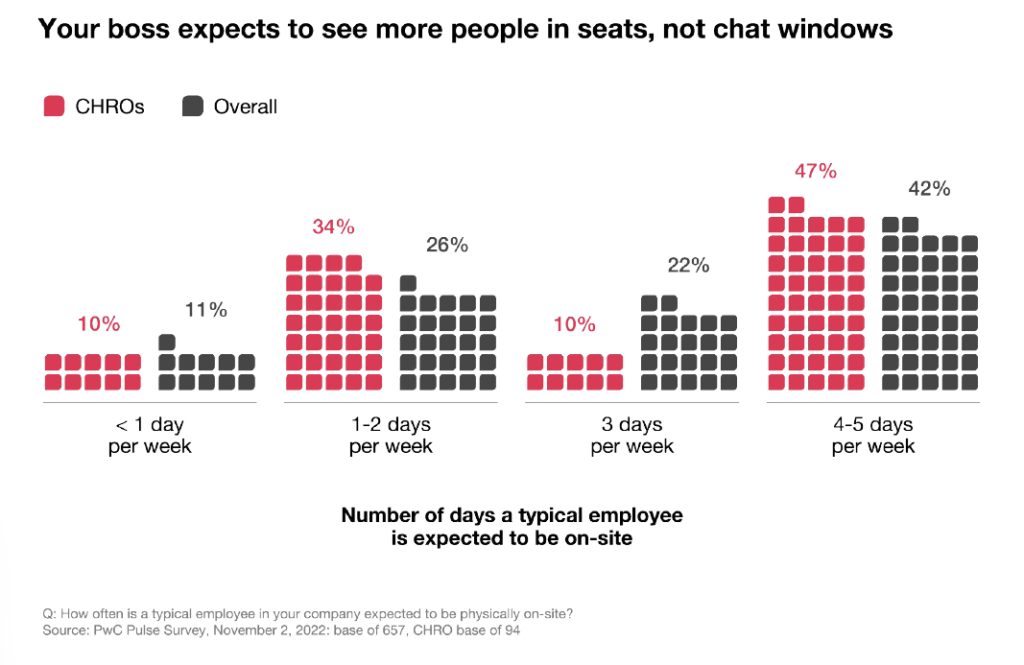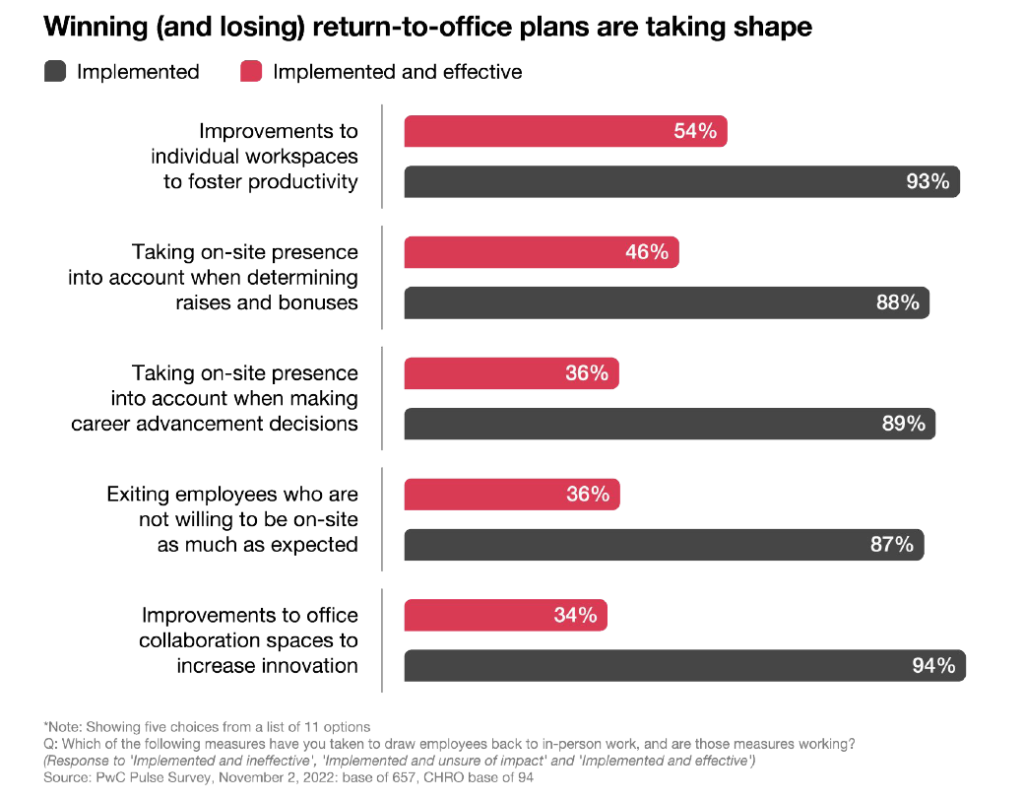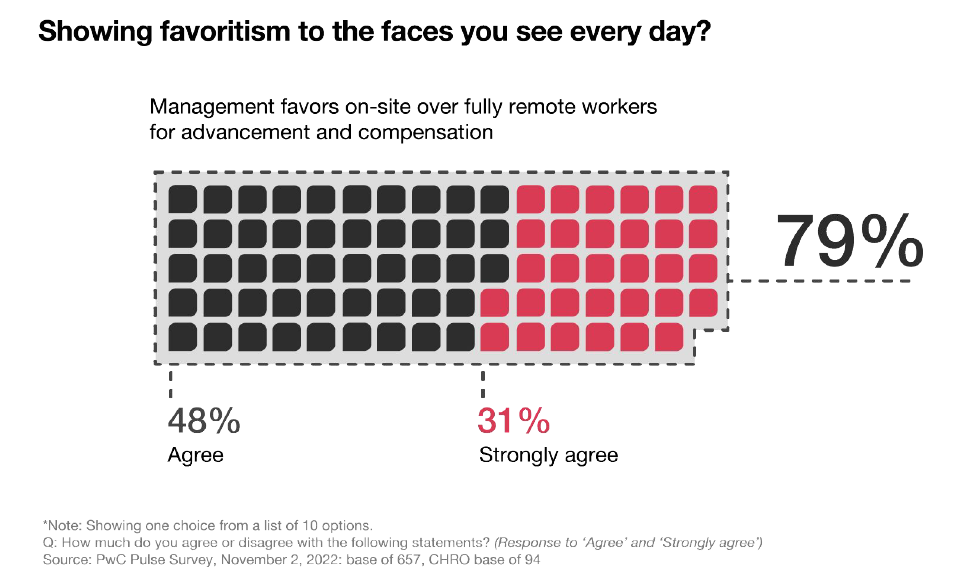Human resource leaders who recently had to transition entire industries to remote work are now finding it equally difficult to bring employees back and keep them engaged while on-site. With a potential recession looming, many CHROs are paring down and streamlining, continuing efficiency improvements and redistributing workloads between staff and contingent workers, according to the latest PwC Pulse Survey. At the same time, CHROs have to balance job and skill requirements, factor in employee preferences to stay competitive and reduce the possibility that management will favor on-site workers over those who opt for hybrid or remote work.
Businesses are paring down workforces ahead of possible recession
When we asked CHROs what they’re doing as a result of the current environment, 81% told us they’re implementing at least one tactic to reduce their workforce to a great extent. Top actions include offering voluntary early retirement packages (43%), performance-based headcount reductions (41%), not replacing employees who leave the company (38%) and hiring freezes (35%).
As the likelihood of a recession grows, companies are proactively looking to reorganize their talent to improve efficiency. While 36% of CHROs say they’re implementing layoffs to a great extent, this varies by industry. Almost the same number of CHROs (34%) report shifting the ratio of staff to contingent labor to a great extent and 43% report upskilling existing staff for upward or lateral role changes.
As we look to the next 12 to 18 months, a quarter (26%) of executives overall are planning to reduce the number of full-time employees, and 34% of CHROs say the same. Perhaps even more surprising, over that same time period, 44% of all executives say they are hiring in specific areas to drive growth. It’s about making sure the company has the right people with the right skills in the right positions.
What you can do
● As you approach workforce planning, consider all options, including alternative talent models. Can you use contingent labor for specific activities, allowing for more flexibility if there is a downturn? Can you move employees around based on their skill sets and potentially automate lower-level tasks?
● Consider recession readiness before outright headcount reductions. Revisit your benefits and rewards and look for ways to scale back. Look for cost efficiencies and tax benefits such as the Covid-19 Employee Retention Credit (ERC). Be clear on what your company’s talent philosophy is related to a recession. Will you implement a no-layoff policy or will you rely on headcount cuts, and what is your threshold for each?
● Create a cost- and tax-efficient approach to voluntary retirement and reductions in force. If you determine that it’s appropriate to lay off workers, make sure your strategy is both effective and empathetic.

There’s no one-size answer for heading back to the workplace
Forty-two percent of business executives across industries expect the typical employee to be back on-site four or five days a week, while just 19% expect them once a week or less. This can run counter to what workers want, and also counter to what their work actually requires—many job functions might easily be completed remotely or during non-standard hours.
Younger employees who joined the workforce in the past few years tend to have little affinity or experience with in-person company culture. After years of remote work, even seasoned staff may resent being expected to commute into a physical office only to log on to remote meetings all day. The situation may be compounded if some departments—IT, for example—are allowed to work remotely more often.
At the same time, some workers who aspire to move up the ranks may believe that heading back to the office is critical to networking, getting face time with leadership and volunteering for collaborative, hands-on roles. Still others may simply be unable to work remotely or find it more productive to work from an office.
What’s clear is that workers want different things for different reasons. Preferences are based on work-life balance, where they live, their responsibilities outside of work, their career aspirations and other factors. There’s no one-size-fits-all approach to determining a company’s or even a department’s on-site policy.
What you can do
● Consider reinventing your employee experience, focusing on providing meaningful work, inclusive culture and customized offerings (such as workspaces and rewards).
● Empower individual teams and people managers to collaborate at the local level. Agree on why teams come back to the office and what’s in it for them, and try to develop schedules that allow for some team and personal preferences. Provide leadership training so that managers are more effective at managing people across teams and locations.
● Revisit your performance management processes and rewards. Successful hybrid models should take into account overall employee impact—while some jobs need to be performed on-site, others can be just as reliably performed elsewhere.
● Consider offering choice and flexibility to empower workers to own their career development as well as connect their personal ambition to the overall corporate mission.

Employers use both carrot and stick to draw workers back in person
As businesses transition back to in-office modes of work, there’s been no shortage of ideas about how to encourage employees back to their workstations, be they carrot or stick. CHROs say that they’re trying almost everything, and some ideas are working better than others.
Individual workspace productivity improvements—like upgraded computer monitors and better WiFi—have been the most effective, according to 54% of the CHROs in our survey. It’s too early to tell if improvements to cooperative spaces are effective. Only a third (34%) of CHROs say that they’re doing this and it’s working, while another 51% acknowledge that they’re doing this but aren’t yet sure of the impact.
The second most effective method is considering on-site presence when determining raises and bonuses, with 46% saying that they’re doing this and it’s effective. On the other end of the spectrum, exiting employees who aren’t willing to be on-site as much as expected doesn’t seem to be the solution. This type of negative incentive can create an unhealthy culture and working environment and potentially drive away skilled talent.
What you can do
● Provide positive incentives for workers to come into the workplace by creating an environment where they can interact with their teams, access what they need to work efficiently and network with both peers and company leaders.
● Avoid measures with negative repercussions. They’re not proving to be very effective and can run counter to the company culture you’re trying to create.
● Stay nimble. Creative organizations are finding ways to offer flexibility to employees. This often translates into an ability to attract talent away from competitors.

Potential pitfalls of forcing workers back on-site
As some workers head back to the office and others remain either fully remote or hybrid, leaders should recognize the potential for diversity, equity and inclusion (DE&I) issues. According to the U.S. Bureau of Labor Statistics, women were more likely than men to work from home in 2021. Remote work has also been more popular among those with caregiver responsibilities, racially/ethnically diverse communities, those from economically disadvantaged backgrounds and workers with disabilities. Many of these workers have embraced remote and hybrid work opportunities, and they may even drop out of the workforce should those opportunities disappear. Because of these different preferences across protected groups, workplace proximity bias—favoring in-person workers for opportunities and advancement—brings risks of causing disparate impact when it comes to raises and career advancement.
What you can do
● Recognize how your employees are contributing, regardless of whether workers are remote, hybrid or on-site.
● Provide training on potential workplace biases with a hybrid workforce. Review talent processes to help confirm that they are inclusive.









